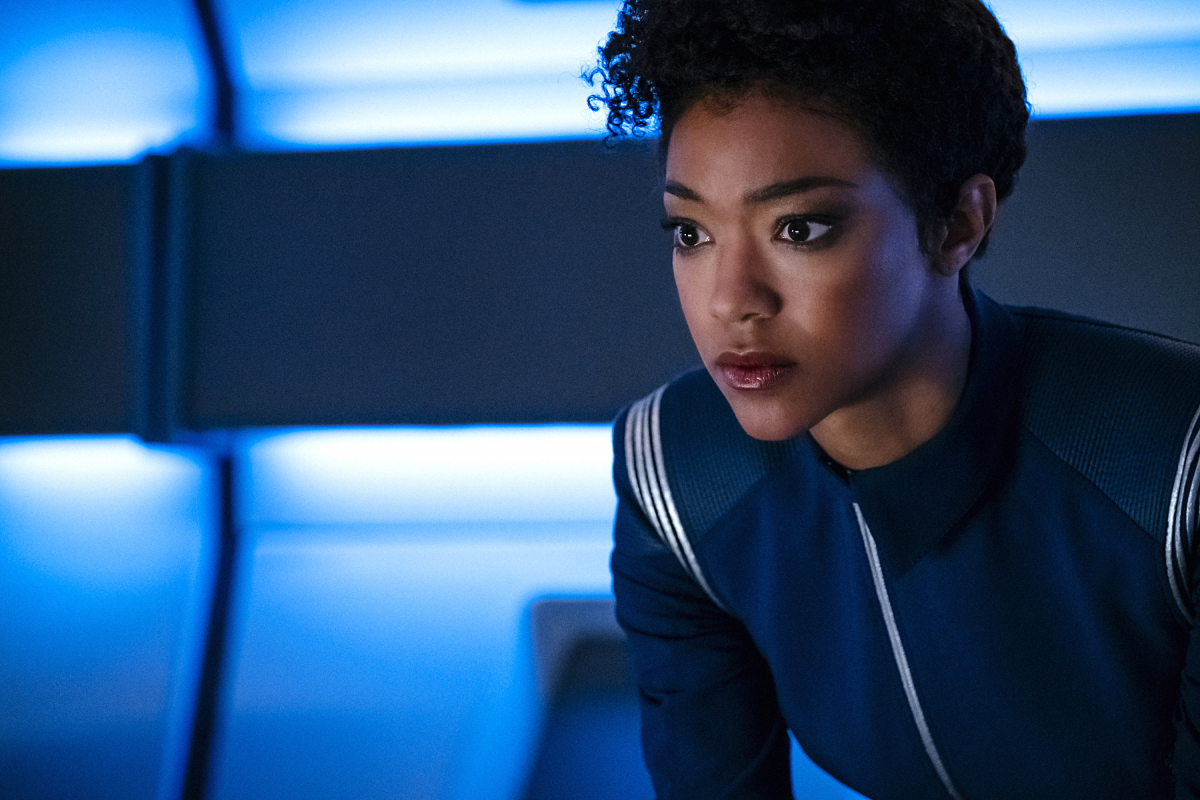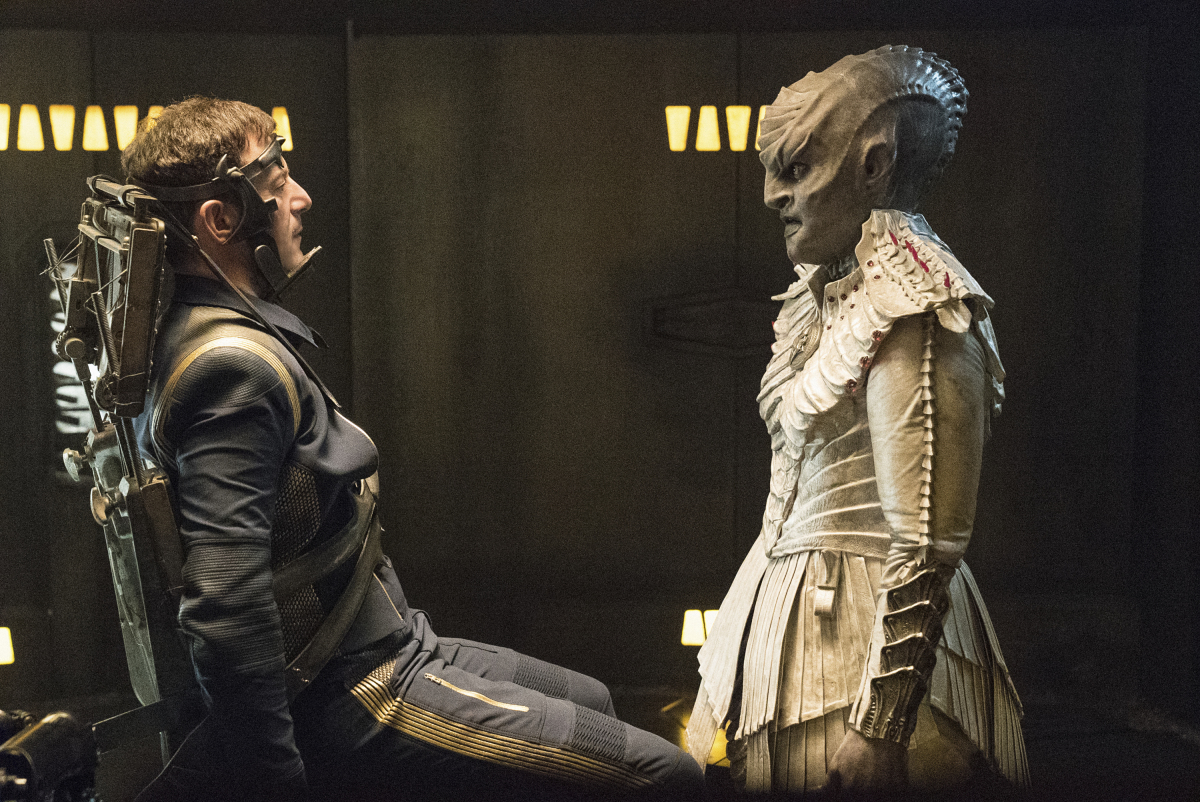'Star Trek: Discovery' Mudd-ies Up Tardigrade Science

Warning: This recap includes spoilers for Episode 5 of "Star Trek: Discovery."
"Star Trek" has always been about breaking boundaries, even back in the 1960s. The original "Star Trek" series (TOS) was famous for featuring what is widely considered the first interracial kiss on broadcast television. Other episodes were thinly disguised commentaries on the futility of the Cold War. Even in later series, characters have always confronted touchy themes such as torture, war and intercultural conflict.
So it should be no surprise that "Discovery," though fresh out of the gate, is already breaking new ground for "Star Trek." The latest episode, which aired last night (Oct. 15), included what might have been the series' first f-bomb, a loving (yet platonic) scene between two gay characters, and gritty depictions of torture that are almost as heart-wrenching as Picard's famous "there are four lights" episode ("Chain of Command") in "The Next Generation," 25 years ago. Obviously, viewer discretion (especially for concerned parents of younger children) is advised.
But first, let's quickly address the plot. Michael Burnham (Sonequa Martin-Green), worried that the spore drive is damaging the tardigrade's health, takes her concerns to several other crewmembers. Her worries are not warmly received by senior officers, especially because the USS Discovery is doing really, really well in the war, thanks to its ultrafast transportation capabilities. [The 10 Best Star Trek Episodes (Including All Network Series)]
Then, the Klingons capture and beam aboard Capt. Gabriel Lorca (Jason Isaacs) while he is traveling in a small transport ship. With the Klingons warping away to parts unknown, the Kelpien 1st Officer Saru (Doug Jones) is in charge. For him, loyalty — especially to his captain — always comes first. To Saru, the tardigrade's health is a much lower priority than rescuing Lorca before the Klingons torture and kill him.
Honoring the original series
Speaking of TOS, longtime fans of "Star Trek" got a great treat in this episode: They got to learn a little more about Harcourt Fenton Mudd. The notorious trickster appeared in two episodes of TOS and one episode of The Animated Series, and was pretty shady even for his day; his episodes usually involved mistreating women or spreading evil love potions among crews.
Mudd is delightfully reprised by Rainn Wilson (best known for playing the quirky Dwight Schrute in "The Office"), who makes a refreshing change from characters exhibiting Starfleet's trademark derring-do attitude. His take on the Klingon war may not be fully fair, but it is nice to hear from somebody who (in his words) represents the people "down there," — the millions who live and work planet-side below the starships that travel the universe. And these people are tired of "Starfleet arrogance," he adds.
Get the Space.com Newsletter
Breaking space news, the latest updates on rocket launches, skywatching events and more!
"The moment you decided to boldly go where no one has gone before — what did you think would happen when you bumped into someone who didn't want you in your front yard?" he says to Lorca while the two are trapped inside a Klingon prison cell.
Mudd and Lorca's conversation is interrupted by a Klingon, who demands to a prisoner, "Choose your pain." That means the prisoner must choose either to be tortured himself or to pick another victim for horrible treatment. The Klingons repeat this exercise a few times, including a torture sequence involving Lorca. It turns out that Lorca's eyes are extremely photosensitive, which makes it hard for him to bear bright lights.
Mudd also calls out Lorca over his last command, on the USS Buran. It turns out that Lorca was the only one to escape a Klingon attack; in fact, he blew up the ship (damaging his eyes in the process) because he felt it was better for everyone to die than to face Klingon torture. ("Not my crew, not on my watch," Lorca says bluntly regarding the harsh choice.)
By the episode's end, Lorca has escaped (with the help of another crewmate and the USS Discovery, which we'll get into in a moment). They force Mudd to stay behind, with Mudd shouting that it will not be the last time we hear of him. During the escape, we learn why Lorca chose not to get his eyes fixed: "We choose our own pain," he tells another crewmember. "Mine helps me remember," he adds, showing a bit of humanity for the first time since we met him.
Tardigrade trouble
Speaking of humanity, the tardigrade's obvious distress causes worry among Burnham, Lt. Paul Stamets (Anthony Rapp) and Burnham's roommate Cadet Sylvia Tilly (Mary Wiseman). The three need to work quickly to find an alternative to the current spore drive setup, which requires the tardigrade to interface with special mushroom spores to get the Discovery to jump vast distances.
Together, they review how the system works, greatly benefitting viewers who may have been confused by the perplexing explanation in Episode 4 (although really, it's still pretty hard to follow). In a nutshell, their explanation suggests that mycelium spores (from a fictional mushroom) are spread across the universe in a matrix that serves as an intergalactic transportation system. The tardigrade, which is adorably called Ripper, has a symbiotic relationship with the spores and can incorporate them into its DNA (using "horizontal gene transfer," to get supertechnical.)
Stamets supposes that a way to replace the tardigrade would be by finding a compatible species that "understands its role in the process and participates willingly," unlike the poor tardigrade that is sentient, and understandably unhappy with being strapped into a painful system. Or perhaps, the crew members reason, they could come up with a virtual tardigrade. Tilley blurts out, "That is f---ing cool," and then apologizes. But Stamets repeats her words: "No, cadet, it is f---ing cool."

But their progress is not fast enough for Saru, as Discovery's crew closes in on the Klingons' position. The tardigrade literally shrivels after a couple of jumps, releasing its water system and curling into a fetal position. Saru orders Stamets to get the tardigrade operational, and Stamets complies, to looks of horror from some of his colleagues.
But don't worry. Stamets takes the tardigrade's place, because guess what? Humans share a lot of tardigrade DNA, and Stamets had a magic way of injecting more tardigrade stuff inside of him, using what looks like a phaser. Stamets gets supersick, then superhysterical, but appears to be just fine within a few minutes. This plot point is poorly explained, but ultimately, the tardigrade survives and gets released into space, Lorca returns to Discovery safe and sound, and Stamets' partner delivers a cute line as the couple brushes their teeth at episode's end: "You may not care about yourself, but I do."
Discovery is quickly approaching the halfway point of its first season, and one weakness is becoming clear: The show is trying to fit a lot into a short while. The tardigrade/spore drive science is confusing; several reviewers (not just me) — and, presumably, viewers — may be wondering what is going on as well. Another concern is that the show may not be as family-friendly as other "Star Trek" series, although you could argue that "Star Trek" was always a show with mature themes (even if it wasn't obvious to younger audiences).
But let's not obscure the good bits. The show has a great cast and an excellent stable of guest stars, it's referencing older series and it's maintaining a feverish pace for action with the Klingons. Let's hope the commanders of this series' starship rein in the confusion and focus more on the plot, to keep viewers happy.
Follow us @Spacedotcom, Facebook and Google+. Original article on Space.com.
Join our Space Forums to keep talking space on the latest missions, night sky and more! And if you have a news tip, correction or comment, let us know at: community@space.com.

Elizabeth Howell (she/her), Ph.D., was a staff writer in the spaceflight channel between 2022 and 2024 specializing in Canadian space news. She was contributing writer for Space.com for 10 years from 2012 to 2024. Elizabeth's reporting includes multiple exclusives with the White House, leading world coverage about a lost-and-found space tomato on the International Space Station, witnessing five human spaceflight launches on two continents, flying parabolic, working inside a spacesuit, and participating in a simulated Mars mission. Her latest book, "Why Am I Taller?" (ECW Press, 2022) is co-written with astronaut Dave Williams.









